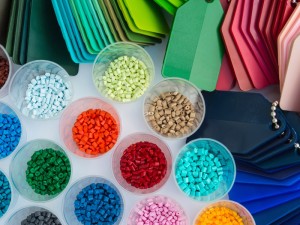A feature that distinguishes PVC from other thermoplastic materials is the ability to modify its physical and mechanical properties via plasticizing, which has long been a widely used means of modification.Plasticizers are added to PVC in order to achieve the required level of flexibility of the end product.Their main task is to decrease the Tg (the glass transition temperature) of the PVC, which in turn leads to a lowering of the gelling and moulding temperature during processing.This also leads to a permanent improvement of the properties of the polymer, including itsflexibility, impact resistance and resistance to low temperatures.Plasticizers, which this article provides a general overview of, are one of the wide array of additives used in PVC processing. They will be discussed in more detail in subsequent articles.Plasticizers can be classified based on different criteria, such as:
– process characteristics (high-temperature, low-temperature plasticizers),
– type of chemical (phthalates, phosphates, polyesters etc.),
– molecular weight (monomeric, polymeric).
The most common plasticizer groups include:
- phthalic acid esters (DEHP, DIDP, DINP) (DTDP),
- adipic acid esters (DINA), (DIDA) – added to products used in low temperatures,
- sebacic acid esters (DBS), (DOS) – provide PVC plastificates with resistance to low temperatures,
- phosphate softeners-used in PVC plastificates with reduced flammability,
- polymeric softeners-characterized by low migration and resistance to extraction,
- trimelliates – used in PVC plastificates resistant to high temperatures.
- phthalate-free – introduced in response to restrictions placed on phthalate plasticizers (e.g.Grupa Azoty – Oxoviflex® – DEHT :used in the production of carpets, vinyl wallpaper, flexible pipes (plumbing), cable tubing and conduits, artificial leather, packagings and plastic films, PVC coatings, products for children)
There is also another division of plasticizers into primary and secondary type, which is based on their solvation properties and degree of compatibility with PVC. These will be described in subsequent articles.In accordance with the requirements of Directive 2005/84/EC relating to the classification, packaging and labelling of dangerous substances, it is being recommended that six phthalates be eliminated (BBP, DBP, DEHP, DINP, DIDP, DNOP).This subject and other information about phthalates and plasticizers are going to be discussed in the articles to come.
Due to PVC degradation that occurs during processing, PVC needs to be mixed with stabilisers in order to prevent its destruction. Stabilisers also help PVC to maintain its properties in the course of its lifetime.Poly(vinyl chloride) is very sensitive to elevated temperatures and light, and undergoes significant destruction when exposed to these factors.In order to prevent the thermal deterioration of PVC during processing and light-induced degradation of the finished product, chemical compounds with a stabilising effect are used.
Stabilisers consist of a wide variety of chemical substances. They are added to PVC alone or in multi-component blends demonstrating a synergistic effect. The latter are prepared in a dust-free form as so-called “one-pack” stabilisers. Their composition is adapted to the processing conditions and to the intended use of the product.
At the moment, the main stabilisers used with PVC include:
- blends of metal-based stabilisers – Ca, Ca-Zn, Zn-Mg, Ba-Ca and Ba-Zn-Ca (generally stearates).They are suitable for stabilization of non-plasticized, semi-hard, plasticized PVCs and plastisols.Zn-Mg stabilisers are used in hard and flexible blends in place of obsolete
Ba-Cd stabilisers, whereas Ba-Zn stabilisers are a substitute of cadmium-based stabilisers.
In turn, Ba-Zn and Ca-Zn stabilisers are used with softened PVCs as a substitute for lead stabilisers.Ca-Zn stabilisers are used primarily for products made of plasticized poly(vinyl chloride) (PVC-P), intended for use in products which come into contact with food and in those used by children.
- organotin stabilizers – i.e. butyl, octyl and methyl tin mercaptides, butyl and octyl tin carboxylates and octyl tin maleates.PVC products which incorporate these stabilisers are characterised by a high level of transparency.They are especially suitable for the stabilisation of hard PVC processed via calendering, extrusion and injection moulding.
- organic stabilisers – including organotin compounds, organic phosphites, epoxy compounds, aminocrotonates and a-phenylindoles.
This part of the article will present 2 of the largest groups of additives, while part II will deal with lubricants, impact modifiers, fillers and dyes used in the processing of PVC.
Literature:
- Babinsky R.: PVC additives: A global review. Plast. Add. Comp. 2006, 8(1), 38-40.
- Charles E. Wilkes, James W. Summers, Charles Anthony Daniels, Mark T. Berard, „PVC Handbook”, 2005
- Saechtling H., „Tworzywa sztuczne. Poradnik”, Warszawa 1955,2000
- Obłój-Muzaj M., Świerz-Motysia B., Szabłowska B., „Polichlorek winylu”, Warszawa 1997
- K. Bortel, „Środki pomocnicze stosowane w przetwórstwie tworzyw polimerowych”, cz.2, „Przetwórstwo Tworzyw”, 6/(126)/14, s.148-153, 2008
- www.specialchem.com
- Summers J.W.: “A review of the principles of poly(vinyl chloride) compound processing and dispersion”. Materiały Konferencji „Vinyltec” Iselin NJ 2004, 157-166, SPE Ed.
- Starnes W.H. Jr.: Structural defects in poly(vinyl chloride). J. Polymer Sci. – Chem. 2005, 43(12), 2451-2467.
- Plasticizers”, Ullmann’s Encyclopeaedia of Ind. Chem./ vol. A20, 439-458,1 992
- Minsker K.S.: “Principles of stabilization of poly(vinyl chloride).” Polym. Plast. Technol. Eng. 1997, 36(4), 513-525.
- Santamaría E., Edge M., Allen N.S., Harvey H.B., Mellor M., Orchison J.: “New insights into the degradation mechanism of poly(vinyl chloride), based on the action of novel costabilizers.” J. Appl. Polym. Sci. 2004, 93(6), 2731-2743.
- Broniewski T., Kapko J., Płaczek W., Thomalla J.: Metody badań i ocena właściwości tworzyw sztucznych, WNT Warszawa 2000
- Szlezygier W.: Tworzywa sztuczne. Chemia– Technologia Wytwarzania– Własności– Przetwórstwo– Zastosowanie. Wydawnictwo Politechniki Rzeszowskiej, Rzeszów 1996.
- „Plasticizers”, Kirk-Othmer Encyclopaedia of Chemical Technology, vol. 19, 1996, 258-290

